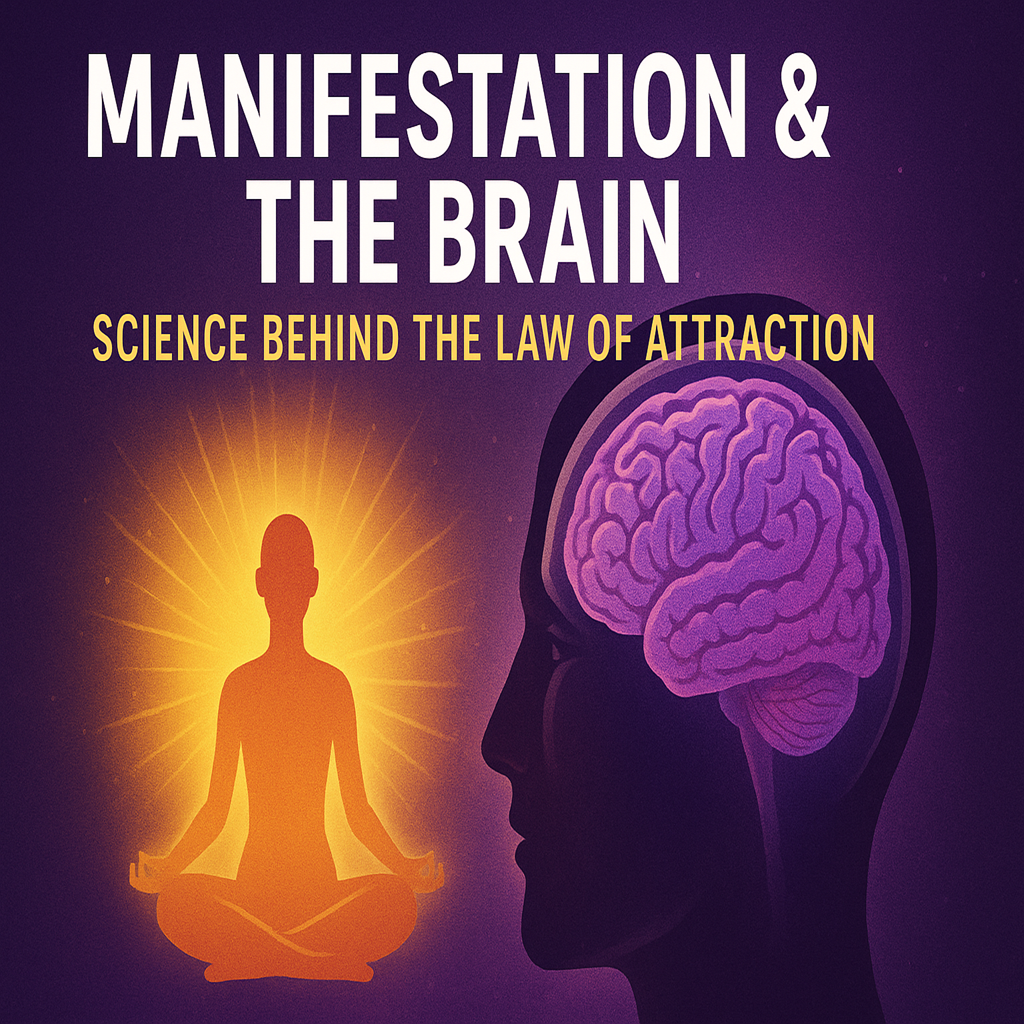
Manifestation & The Brain: Science Behind the Law of Attraction
Manifestation has become one of the most popular topics in self-help and spiritual communities, but what exactly does it mean? At its core, manifestation refers to the process of turning thoughts, beliefs, and intentions into reality. The idea gained worldwide recognition through the Law of Attraction (LOA), which claims that “like attracts like.” In simple words, your dominant thoughts and emotions attract similar experiences into your life.
For many, this sounds mystical or purely spiritual. However, recent research in neuroscience, psychology, and quantum theory reveals that there is a scientific basis behind manifestation. The human brain is not just a passive receiver of information — it is an active generator of perception, emotion, and behavior. When we align our focus, emotions, and actions, we can rewire the brain and influence outcomes in our lives.
This article explores the science behind manifestation, focusing on how the brain processes beliefs, emotions, and visualization, and why the Law of Attraction is more grounded in psychology than magic.
The Law of Attraction Explained
The Law of Attraction (LOA) suggests that your mental state influences your reality. If you consistently think positive, abundant thoughts, you will attract positive and abundant circumstances. Conversely, negative or limiting thoughts tend to draw negative outcomes.
Key principles of LOA include:
- Thoughts become things what you focus on expands.
- Emotions are magnetic your emotional frequency attracts similar energy.
- Belief systems shape reality subconscious beliefs guide your choices and opportunities.
- Visualization creates alignment mental imagery activates neural pathways that prime you for action.
Critics often dismiss LOA as pseudoscience. However, modern psychology provides evidence that beliefs and focus directly influence behavior, perception, and even brain chemistry.
Learn more about Trading psychology and how can Billionaires Success Secrets makes you expert in trading.
The Brain’s Role in Manifestation
1. Reticular Activating System (RAS): The Brain’s Filter
The Reticular Activating System (RAS) is a network of neurons in the brainstem that filters the information we perceive. Every second, our brain receives millions of sensory inputs, but we consciously process only a fraction.
The RAS decides what’s important to notice. For example:
- If you are thinking about buying a red car, suddenly you notice red cars everywhere.
- If you believe you’re unlucky, your brain highlights negative events and ignores positive ones.
This selective attention is exactly how manifestation works: what you focus on becomes more visible and achievable. LOA isn’t magically pulling things into your life — it’s training your RAS to filter reality in a way that aligns with your goals.
2. Neuroplasticity: Rewiring the Brain
Neuroplasticity refers to the brain’s ability to form new connections and reorganize itself. Every time you repeat a thought, visualize an outcome, or affirm a belief, your brain strengthens those neural pathways.
- Positive affirmations can weaken negative self-talk circuits.
- Visualization activates the same brain regions as real experiences, making your brain believe it already happened.
- Repeated manifestation practices “install” new belief systems into the subconscious.
This means that manifestation is not just wishful thinking — it’s a process of neurological reprogramming.
3. Mirror Neurons and Emotional Energy
Discovered in the 1990s, mirror neurons are brain cells that fire both when we perform an action and when we watch someone else perform it. They help us empathize and “tune into” the energy of others.
When practicing manifestation, your emotional energy signals to others how they should respond to you. For example:
- A confident person attracts respect and opportunities.
- An anxious, doubtful person unconsciously repels success.
Manifestation works because our brains communicate emotional energy non-verbally through tone, body language, and subconscious cues.
4. The Subconscious Mind and Belief Systems
Around 95% of our thoughts and behaviors are driven by the subconscious mind. This part of the brain stores beliefs, habits, and emotional memories.
If your subconscious holds beliefs like “I don’t deserve wealth” or “love is dangerous,” manifestation efforts may fail. That’s why many manifestation teachers emphasize affirmations, hypnosis, or meditation — to reprogram limiting beliefs stored in the subconscious.
Science That Supports Manifestation
1. Visualization Studies in Sports Psychology
Numerous studies in sports science show that mental rehearsal improves performance . Athletes who visualize their routines activate the same neural circuits as when they physically perform them. This strengthens muscle memory and boosts confidence.
For example, basketball players who visualized free throws improved almost as much as those who physically practiced them. This proves that the brain doesn’t clearly distinguish between imagination and reality — a key concept behind manifestation.
2. The Placebo Effect
The placebo effect demonstrates the power of belief. Patients who believe they are receiving treatment often show real improvements, even if the treatment is a sugar pill. This shows that belief alone can trigger measurable biological changes in the brain and body.
Manifestation works on the same principle: if you believe strongly enough, your brain and body align with that belief.
3. Quantum Physics and Observer Effect
While often misused in spirituality, some concepts in quantum physics are relevant. The observer effect suggests that observation influences particle behavior. This aligns metaphorically with manifestation: where attention goes, energy flows.
Though not proof of LOA, it highlights how consciousness may play a role in shaping reality.
Practical Techniques to Manifest Using the Brain
a) Visualization with Emotion
- Imagine your desired outcome vividly.
- Add sensory details (sight, sound, touch).
- Feel the emotions as if it has already happened.
b) Affirmations and Positive Self-Talk
- Replace limiting beliefs with empowering statements.
- Example: Instead of “I’m unlucky,” say “Opportunities are always coming my way.”
c) Gratitude Practice
- Gratitude rewires the brain to focus on abundance.
- Daily gratitude journaling increases dopamine and serotonin.
d) Meditation and Mindfulness
- Calms the RAS and subconscious resistance.
- Helps align thoughts with desires.
e) Action + Alignment
- Manifestation is not passive. You must act in alignment with your goals.
- The brain motivates you to notice and seize opportunities.
Common Misconceptions About Manifestation
1) “Just thinking will make it happen.”
- Thoughts alone are not enough. You must combine visualization with emotions and action.
2) “It’s supernatural or magical.”
- Manifestation is rooted in psychology and neuroscience. It works through focus, belief, and behavior changes.
“Negative thoughts instantly attract bad things.”
- Occasional negative thoughts won’t ruin your life. It’s consistent focus and belief systems that matter.
Benefits of Manifestation Backed by Science
- Boosts confidence Visualization improves self-image.
- Reduces stress Gratitude lowers cortisol levels.
- Enhances motivation Clear goals activate dopamine reward pathways.
- Improves resilience Positive focus strengthens coping strategies.
- Strengthens relationships Positive energy attracts supportive people.
Conclusion:
Manifestation and the Law of Attraction are not merely mystical ideas — they are deeply connected to how the brain functions. From the Reticular Activating System . iltering reality, to
neuroplasticity rewiring belief systems, to emotional energy influencing others, manifestation is essentially a process of aligning the brain, body, and actions with desired outcomes.
The science shows that thoughts influence focus, focus shapes behavior, and behavior creates results. Manifestation is not about waiting for miracles; it’s about training your brain to recognize opportunities, build confidence, and take aligned actions.
In short, the Law of Attraction works because your brain is designed to manifest what you truly believe in.

